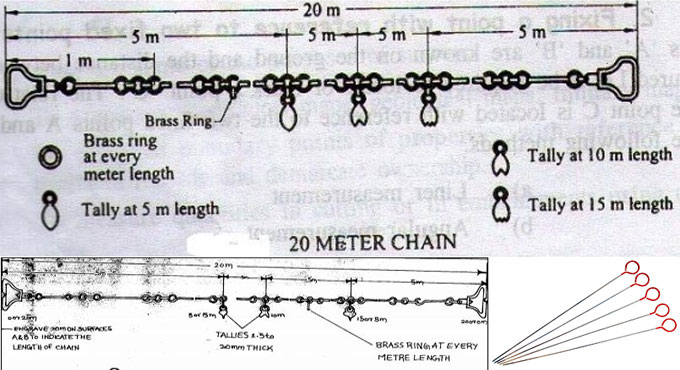
Why Do We Use Arrows in Surveying?

Surveying is the process of measuring the characteristics of the land upon which a construction work is supposed to take place. One of the most common ways to do surveys is to use chain surveying. In this method, we can use special pins, called ?arrows? for marking purposes.
Arrows are often used in surveying large flats of lands. In this situation, the measuring chain length is often shorter than the stretch of land that has to be measured. Then, a pin is stuck in the ground to mark the ends of the chain, and at the end, the pins are counted, and knowing the length of the chain beforehand, we can find out the length measured in this way.
This idea, however, gets fouled when the ground is hard or rocky. Then some digging or poking may be required.
The pins or ?arrows? are 4 mm in diameter, and can be up to 500 mm long. They are quite strong ? each arrow has the tensile strength of 700 N/sq.mm. However, the ideal measurements of an arrow should be 400 millimeters, with 50 mm diameter loop. Be that as it may, arrows cannot be smaller than 25 centimeters.
There is a hooked ring at the end of each arrow, covered in plastic coating, for two reasons. One, it helps to handle the arrows, especially picking them up quickly and stringing them along from a cord or wire.
Secondly, when stuck in the ground, something bright (often a brightly colored ribbon) can be tied at the end to increase the visibility of them from long distance. This helps greatly while surveying large fields or places overgrown with vegetation.
Materials of Surveying Arrows:
Generally, quality steel is used to make surveying arrows. The steel has to be hardened and tempered, cut from such steel wire. To handle rough usage and repel environmental damage, this is coated with black enamel, preferably.
Usage of Arrows in Surveying:
1. To survey sectors, arrows are used mark boundaries and important points.
2. In chain surveying, to mark the ends of the chains delimiting distance.
Advantages of using arrows in surveying:
1. Arrows help you to precisely locate points in the ground, when you are surveying huge areas.
2. Arrows can be fixed on ground to mark an area, thus giving you a sense of the map.
3. Survey arrows are lightweight and are quite easy to handle.
4. These arrows, due to their enamel coating and material, can be used in any weather.
Differences between arrows and pegs in surveying:
Pegs are wooden stumps hit into ground to mark points, much like arrows. However, they are much different from arrows by the following facets:
1. Pegs are wooden but arrows are made of hardened and tempered steel.
2. Arrows and pegs differ greatly in shape ? arrows have a sharp, pointed end and another looped. Pegs, however, are thicker, and have a tapered end.
3. Pegs are much shorter than arrows ? they don?t get longer than 150 mm while arrows start from 250 mm.
4. Arrows are much slenderer than pegs. They are 4 mm in diameter while pegs are 25-30 mm thick.
5. Arrows are specialty equipment ? you don?t generally use them in anything but chain surveying. However, pegs are quite commonplace and are seen in all kinds of surveying.
6. Arrows are used to mark the ends of the chain length, but pegs are used to mark the end of the survey line.


